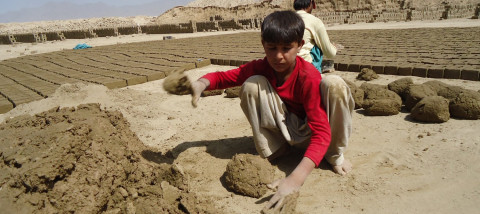
GCED Basic Search Form
Quick Search
You are here
News

More than half of Afghanistan’s people are unable to meet their basic needs, living on less than a dollar a day — the amount of money determined as required to survive — according to Shubham Chaudhuri, the former World Bank country director for Afghanistan.
“I think the state of poverty in Afghanistan today is that it is deep and it is widespread," he told the Associated Press, revealing that more than three-quarters of the population are close to reaching that same level of great financial decline.
The increased financial struggle the country is experiencing, as well as the closure of hundreds of schools due to violence conflict, and poor enforcement of labor laws have led to an increase in child labor.
Last year, the United Nations reported that more than 2 million children in Afghanistan, between ages 6 and 14, perform some type of child labor.
"My children wake up early in the morning and right after prayers they come here for work, so they don't have time for school," Atiqullah — who works at a brick factory with his family, including his 10-year-old son, Kamran — told the Associated Press.
A recent World Bank report said that political stability and an increase in security in the country could help bring skilled workers back from overseas and encourage investment. But the country's future remains unclear.
Much of the billions of dollars in aid that the United States and other governments have provided has not reached the country’s people or its mos vulnerable. Instead, it has ended up lining the pockets of rogue militia leaders.
Afghanistan had the slowest economic growth rate in all of South Asia in 2018 due to drought, ongoing fighting, and rampant corruption. And violent conflict, as well as extreme poverty, has pulled many of the country’s children out of school. These children now spend their days begging on the street or forced into child labor in order to survive.
Both children and adult laborers work in harsh conditions. Many villagers work in brick kilns in the stifling summer heat to pay off loans, provided by brick factory owners, used to fulfill basic needs. According to brick laborers, a family of 10 working in the factories can bring in an average income of $12-18 a day, fluctuating based on their overall productivity.
While Afghanistan does have child labor laws, they are not strictly imposed, especially in villages where the people are severely economically disadvantaged.
Working alongside Atiqullah’s family in the brick kilns is 65-year-old Jan Agha, who has been labored away in an effort to pay back loans he took out of necessity for three decades — he said does not see an end in sight for his family. Now his four sons join him at work, and he believes that life will be the same for the next generations of his family.
"We always think about our future. We don't know how long we will live with economic problems like this, when we will be able to live our own lives, when we will be able to breathe in freedom. Right now we live like slaves,” he said.
But for Afghan’s poor, it is the only way to endure until the country’s economic and political situation improves.
"These days if you don't work, you cannot survive,” Atiqullah said.
URL:
https://www.globalcitizen.org/en/content/afghanistan-child-labor/
